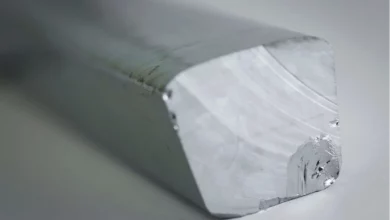Imagine an assembly of intelligent, tiny specks patrolling the inside of your body for the first sign of anything unusual. Unfriendly bacteria, dormant viruses, hardened arteries, suspiciously multiplying cells, faulty DNA–all are zapped or cleared away with precision and care by these ever vigilant overseers.
Imagine, in other words, having the ultimate immune system.
Such imaginings, some may argue, belong in the realm of science fiction. What does it even mean to “program” minuscule particles to hunt down certain diseases within the body, or to have them deliver particular drugs to specific regions within a particular cell?
As it turns out, that is precisely what researchers are working on now at the American University in Cairo.
The field is bionanotechnology, a somewhat clumsy term denoting the merger of biotechnology and engineering on a seriously small scale–smaller than 100 billionths of a meter to be precise, hence the word "nano."
To see how these two fields work together, picture a tiny organism–the bio component–inside a nano-sized submarine, here representing the technical structure. Set them off on a mission, and you have bionanotechnology at work.
For Professor Hassan Azzazy, head of AUC’s chemistry department, such a mission is already underway, detecting Hepatitis C (HCV)–an infectious and often deadly disease affecting the liver, which is believed to plague some nine million Egyptians, making Egypt the worst-affected country in the world.
He and his students at the AUC’s Yousef Jameel Science and Technology Research Center (YJSTRC), have been conducting some eyebrow raising science, installing antibodies onto gold nanoparticles–minuscule specks of gold–which then “recognize” and latch onto markers of the virus.
In this way, the antibodies, which are basically proteins, propel the “submarines” to which they are attached to pursue HCV wherever it is hiding.
“Gold nanoparticles have special optical properties," Azzazy explains with abundant enthusiasm. "When they are suspended in a solution, they give it a visible red color. But when they find something they recognize [e.g. HCV] and congregate around it, the color changes to a very clear blue.”
This property has the capacity to revolutionize how we detect diseases in the body, and, thereby, how patients are diagnosed. HCV is a disease notorious for being asymptomatic, potentially staying inside the liver of a carrier for decades before suddenly manifesting itself in its later, deadlier stages. It is also not easy or cheap to diagnose, which means that mass public screenings for the virus, the first step to treating a cross-generational endemic disease, according to Azzazy, is a difficult undertaking.
Yet with the detection techniques being developed in bionanotechnology, all that is required for diagnosis is a small sample of blood, into which the nanoparticles are dropped. If the virus is detected, the antibodies in the gold nanoparticles will be drawn to it, consequently changing their color to reflect blue.
“This is not only a simple and quick procedure,” says Azzazy, “it is also incredibly cost effective, doing away with the need for expensive instruments and trained technicians.” Azzazy assures that while the nanoparticles are made of gold, their cost, in the amounts required at the nanoscale, is small.
This is only a first step of things to come. Ultimately, this technique and similar ones that AUC researchers are working on, such as using “quantum dots” or nanocrystals rather than gold particles, will soon advance to the stage of multiplexing: the ability to detect several diseases from a single, small sample of blood. Such technology could save lives in the case of infants, who often don’t have enough blood to spare for three or more separate diagnostic tests. At the same time it would be extremely cost and time effective.
Still, developing a new generation of screening techniques is only one way in which nanobiotechnology is being utilized at YJSTRC. The other is developing drug delivery nanocarriers–in other words, tiny submarines with torpedoes.
“With most drugs,” says Azzazy, “you administer a patient with [the drug] and hope it reaches its target, causing numerous side effects in the process.” Therein comes the idea of tiny nanostructures that can deliver specific molecules of drugs directly to individual infected or malfunctioning cells.
“These are called targeted smart nanoparticles,” says Azzazy. They are "targeted" because they travel to specific parts even within cells themselves, and they are "smart" because they can detect whether the cell is affected, and therefore whether to release the drug or not. Contrast this with chemotherapy, which is a direct attack on virtually every cell in the body launched in the hope of destroying a few, often secluded ones, and it becomes clear how this technique may largely eradicate the problem of side-effects.
Azzazy himself admits that this is an ambitious project. “I always tell my students we need to think outside the box, but I think we’ve actually totally thrown the box away,” he jokes, though ultimately he is serious.
As yet, the team of researchers which Azzazy leads is working only on developing the drug carriers themselves, which they hope to start testing by the end of 2010. Once this stage has been completed, the carriers will be released in liver cell cultures infected with HCV, where it’s hoped they will release their loads in the right cells.
The road seems a long way to any of the scenarios presented above, in which humans are equipped with a 2.0 immune system managed by smart nanoparticles. And concerns and questions remain as to the potential hazards of any such technology, with issues of the potential toxicity and environmental impact of such techniques posing ominous question marks over their future regulation.
Yet even now, one of the world’s leading nanoscience researchers, Egyptian-American chemical physicist Mostafa el-Sayed, is using gold nanoparticles to literally burn cancer cells into oblivion. The technique, called photothermal therapy, relies on the fact that cancer cells are more thermo-sensitive than healthy cells.
There are many other such examples promising a life-changing revolution in the field of disease prevention and treatment, one which would dwarf even the discovery of penicillin. But for now, we have to wait and see.




